Experimental and Numerical Study on Impact Behavior of Hourglass Lattice Sandwich Structures with Gradients
Abstract
:1. Introduction
2. Experimental and Simulation Methods
2.1. Specimen Manufacturing of Regular Sandwich Structures
2.2. Drop Hammer Test
2.3. Finite Element Models of Graded Sandwich Structures
3. Results and Discussion
3.1. Compressive Force of Regular Sandwich Structures
3.2. Validation of FE Models
3.3. Deformation Mode of Graded Sandwich Structures
3.4. Compressive Force of Graded Sandwich Structures
3.5. Peak Force of Graded Sandwich Structures
3.6. Energy Absorption of Graded Sandwich Structures
4. Conclusions
Author Contributions
Funding
Institutional Review Board Statement
Informed Consent Statement
Data Availability Statement
Conflicts of Interest
References
- Mouritz, A.P.; Gellert, E.; Burchill, P.; Challis, K. Review of advanced composite structures for naval ships and submarines. Compos. Struct. 2001, 53, 21–41. [Google Scholar] [CrossRef]
- Meo, M.; Morris, A.J.; Vignjevic, R.; Marengo, G. Numerical simulations of low-velocity impact on an aircraft sandwich panel. Compos. Struct. 2003, 62, 353–360. [Google Scholar] [CrossRef]
- Ning, H.; Janowski, G.M.; Vaidya, U.K.; Husman, G. Thermoplastic sandwich structure design and manufacturing for the body panel of mass transit vehicle. Compos. Struct. 2007, 80, 82–91. [Google Scholar] [CrossRef]
- Najafi, M.; Eslami-Farsani, R. Design and characterization of a multilayered hybrid cored-sandwich panel stiffened by thin-walled lattice structure. Thin-Walled Struct. 2021, 161, 107514. [Google Scholar] [CrossRef]
- Maher, R.; Khalili, S.M.R.; Eslami-Farsani, R. Experimental analysis of corrugated core sandwich panel with smart composite face-sheets under high-velocity impact. J. Compos. Mater. 2022, 56, 1495–1511. [Google Scholar] [CrossRef]
- Johnson, A.F.; Sims, G.D. Mechanical properties and design of sandwich materials. Composites 1986, 17, 321–328. [Google Scholar] [CrossRef]
- Zhang, J.X.; Ye, Y.; Qin, Q.H.; Wang, T.J. Low-velocity impact of sandwich beams with fibre-metal laminate face-sheets. Compos. Sci. Technol. 2018, 168, 152–159. [Google Scholar] [CrossRef]
- Zhang, J.X.; Qin, Q.H.; Zhang, J.T.; Yuan, H.; Du, J.L.; Li, H. Low-velocity impact on square sandwich plates with fibre-metal laminate face-sheets: Analytical and numerical research. Compos. Struct. 2021, 259, 113461. [Google Scholar] [CrossRef]
- Liu, Y.; Zhang, X.C. The influence of cell micro-topology on the in-plane dynamic crushing of honeycombs. Int. J. Impact Eng. 2009, 36, 98–109. [Google Scholar] [CrossRef]
- Zhang, X.C.; An, L.Q.; Ding, H.M.; Zhu, X.Y.; El-Rich, M. The influence of cell micro-structure on the in-plane dynamic crushing of honeycombs with negative Poisson’s ratio. J. Sandw. Struct. Mater. 2015, 17, 26–55. [Google Scholar] [CrossRef]
- Zhang, J.X.; Qin, Q.H.; Xiang, C.P.; Wang, T.J. Dynamic response of slender multilayer sandwich beams with metal foam cores subjected to low-velocity impact. Compos. Struct. 2016, 153, 614–623. [Google Scholar] [CrossRef]
- Evans, A.G.; Hutchinson, J.W.; Fleck, N.A.; Ashby, M.F.; Wadley, H.N.G. The topological design of multifunctional cellular metals. Prog. Mater. Sci. 2001, 46, 309–327. [Google Scholar] [CrossRef]
- Deshpande, V.S.; Flecek, N.A. Foam topology bending versus stretching dominated architectures. Acta Mater. 2001, 49, 1035–1040. [Google Scholar] [CrossRef]
- Clough, E.C.; Ensberg, J.; Eckel, Z.C.; Ro, C.J.; Schaedler, T.A. Mechanical performance of hollow tetrahedral truss cores. Int. J. Solids Struct. 2016, 91, 115–126. [Google Scholar] [CrossRef]
- Sebaey, T.A.; Mahdi, E. Behavior of pyramidal lattice core sandwich CFRP composites under biaxial compression loading. Compos. Struct. 2014, 116, 67–74. [Google Scholar] [CrossRef]
- Lee, B.; Lee, K.; Byun, J.; Kang, K.J. The compressive response of new composite truss cores. Compos. Part B Eng. 2012, 43, 317–324. [Google Scholar] [CrossRef]
- Li, Y.; Gu, H.; Pavier, M.; Coules, H. Compressive behaviours of octet-truss lattices. Proc. Inst. Mech. Eng. Part C J. Mech. Eng. Sci. 2020, 234, 3257–3269. [Google Scholar] [CrossRef]
- Kooistra, G.W.; Wadley, H.N.G. Lattice truss structures from expanded metal sheet. Mater. Des. 2007, 28, 507–514. [Google Scholar] [CrossRef]
- Wang, B.; Zhang, G.Q.; He, Q.L.; Ma, L.; Wu, L.Z.; Feng, J.C. Mechanical behavior of carbon fiber reinforced polymer composite sandwich panels with 2-D lattice truss cores. Mater. Des. 2014, 55, 591–596. [Google Scholar] [CrossRef]
- Zok, F.W.; Waltner, S.A.; Wei, Z.; Rathbun, H.J.; Mcmeeking, R.M.; Evans, A.G. A protocol for characterizing the structural performance of metallic sandwich panels: Application to pyramidal truss cores. Int. J. Solids Struct. 2004, 41, 6249–6271. [Google Scholar] [CrossRef]
- Chiras, S.; Mumm, D.R.; Evans, A.G.; Wicks, N.; Fichter, S. The structural performance of near-optimized truss core panels. Int. J. Solids Struct. 2002, 39, 4093–4115. [Google Scholar] [CrossRef]
- Cheung, K.C.; Gershenfeld, N. Reversibly assembled cellular composite materials. Science 2013, 341, 1219–1221. [Google Scholar] [CrossRef]
- Ni, C.Y.; Li, Y.C.; Xin, F.X.; Jin, F.; Lu, T.J. Ballistic resistance of hybrid-cored sandwich plates: Numerical and experimental assessment. Compos. Part A Appl. Sci. Manuf. 2013, 46, 69–79. [Google Scholar] [CrossRef]
- Wang, B.; Hu, J.Q.; Li, Y.Q.; Yao, Y.T.; Wang, S.X.; Ma, L. Mechanical properties and failure behavior of the sandwich structures with carbon fiber-reinforced X-type lattice truss core. Compos. Struct. 2018, 185, 619–633. [Google Scholar] [CrossRef]
- Yungwirtha, C.J.; Wadley, H.N.G. Impact response of sandwich plates with a pyramidal lattice core. Int. J. Impact Eng. 2008, 35, 920–936. [Google Scholar] [CrossRef]
- Xia, F.; Wu, X.Q. Study on impact properties of through-thickness stitched foam sandwich composites. Compos. Struct. 2009, 92, 412–421. [Google Scholar] [CrossRef]
- Wu, Y.H.; Liu, Q.; Fu, J.; Li, Q.; Hui, D. Dynamic crash responses of bio-inspired aluminum honeycomb sandwich structures with CFRP panels. Compos. Part B Eng. 2017, 121, 122–133. [Google Scholar] [CrossRef]
- Zhang, J.X.; Zhou, R.F.; Wang, M.S.; Qin, Q.H.; Ye, Y.; Wang, T.J. Dynamic response of double-layer rectangular sandwich plates with metal foam cores subjected to blast loading. Int. J. Impact Eng. 2018, 122, 265–275. [Google Scholar] [CrossRef]
- Zhang, J.X.; Zhu, Y.Q.; Li, K.K.; Yuan, H.; Du, J.L.; Qin, Q.H. Dynamic response of sandwich plates with GLARE face-sheets and honeycomb core under metal foam projectile impact: Experimental and numerical investigations. Int. J. Impact Eng. 2022, 164, 104201. [Google Scholar] [CrossRef]
- Liu, Y.; Wu, H.X.; Wang, B. Gradient design of metal hollow sphere (MHS) foams with density gradients. Compos. Part B 2012, 43, 1346–1352. [Google Scholar] [CrossRef]
- Zhang, X.C.; An, L.Q.; Ding, H.M. Dynamic crushing behavior and energy absorption of honeycombs with density gradient. J. Sandw. Struct. Mater. 2014, 16, 125–147. [Google Scholar] [CrossRef]
- Lim, T.C. Functionally graded beam for attaining Poisson-curving. J. Mater. Sci. Lett. 2002, 21, 1899–1901. [Google Scholar] [CrossRef]
- Etemadi, E.; Khatibi, A.A.; Takaffol, M. 3D finite element simulation of sandwich panels with a functionally graded core subjected to low velocity impact. Compos. Struct. 2009, 89, 28–34. [Google Scholar] [CrossRef]
- Ajdari, A.; Nayeb-Hashemi, H.; Vaziri, A. Dynamic crushing and energy absorption of regular, irregular and functionally graded cellular structures. Int. J. Solids Struct. 2011, 48, 506–516. [Google Scholar] [CrossRef]
- Liu, X.R.; Tian, X.G.; Lu, T.J.; Liang, B. Sandwich plates with functionally graded metallic foam cores subjected to air blast loading. Int. J. Mech. Sci. 2014, 84, 61–72. [Google Scholar] [CrossRef]
- Yu, B.; Han, B.; Su, P.B.; Ni, C.Y.; Zhang, Q.C.; Lu, T.J. Graded square honeycomb as sandwich core for enhanced mechanical performance. Mater. Des. 2016, 89, 642–652. [Google Scholar] [CrossRef]
- Li, T.T.; Dai, W.; Huang, S.Y.; Wang, H.; Lin, J. Preparation and characterization of SEBS-g-MAH-filled flexible polyurethane foam composites with gradient-changing structure. Mater. Des. 2019, 183, 108–150. [Google Scholar] [CrossRef]
- Xu, G.D.; Yang, F.; Zeng, T.; Cheng, S.; Wang, Z.H. Bending behavior of graded corrugated truss core composite sandwich beams. Compos. Struct. 2016, 138, 342–351. [Google Scholar] [CrossRef]
- Xu, G.D.; Zhai, J.J.; Zeng, T.; Wang, Z.H.; Cheng, S.; Fang, D.N. Response of composite sandwich beams with graded lattice core. Compos. Struct. 2015, 119, 666–676. [Google Scholar] [CrossRef]
- Feng, L.J.; Wu, L.Z.; Yu, G.C. An Hourglass truss lattice structure and its mechanical performances. Mater. Des. 2016, 99, 581–591. [Google Scholar] [CrossRef]
- Feng, L.J.; Wei, G.T.; Yu, G.C.; Wu, L.Z. Underwater blast behaviors of enhanced lattice truss sandwich panels. Int. J. Mech. Sci. 2019, 150, 238–246. [Google Scholar] [CrossRef]
- Ma, X.M.; Li, X.; Li, S.Q.; Li, R.J.; Wang, Z.H.; Wu, G.Y. Blast response of gradient honeycomb sandwich panels with basalt fiber metal laminates as skins. Int. J. Impact Eng. 2019, 123, 126–139. [Google Scholar] [CrossRef]
- Guo, H.; Takezawa, A.; Honda, M.; Kawamura, C.; Kitamura, M. Finite element simulation of the compressive response of additively manufactured lattice structures with large diameters. Comput. Mater. Sci. 2020, 175, 109610. [Google Scholar] [CrossRef]
- Ruiz, D.G.S.; Jeffers, J.R.T.; Ghouse, S. A validated finite element analysis procedure for porous structures. Mater. Des. 2020, 189, 108546. [Google Scholar] [CrossRef]
- Wei, L.L.; Zhao, X.; Yu, Q.; Zhu, G.H. A novel star auxetic honeycomb with enhanced in-plane crushing strength. Thin-Walled Struct. 2020, 149, 106623. [Google Scholar] [CrossRef]
- Yang, L.H.; Sui, L.; Dong, Y.L.; Li, X.Y.; Zi, F.; Zhang, Z.X.; Yang, S.J.; Yang, J.S.; Wu, L.Z. Quasi-static and dynamic behavior of sandwich panels with multilayer gradient lattice cores. Compos. Struct. 2021, 255, 112970. [Google Scholar] [CrossRef]
- Hanssen, A.G.; Langseth, M.; Hopperstad, O.S. Static and dynamic crushing of circular aluminium extrusions with aluminium foam filler. Int. J. Impact Eng. 2000, 24, 475–507. [Google Scholar] [CrossRef]
- Zhang, X.; Cheng, G.D.; Zhang, H. Numerical investigations on a new type of energy-absorbing structure based on free inversion of tubes. Int. J. Mech. Sci. 2009, 51, 64–76. [Google Scholar] [CrossRef]
- Kooistra, G.W.; Deshpande, V.S.; Wadley, H.N.G. Compressive behavior of age hardenable tetrahedral lattice truss structures made from aluminum. Acta Mater. 2004, 52, 4229–4237. [Google Scholar] [CrossRef]

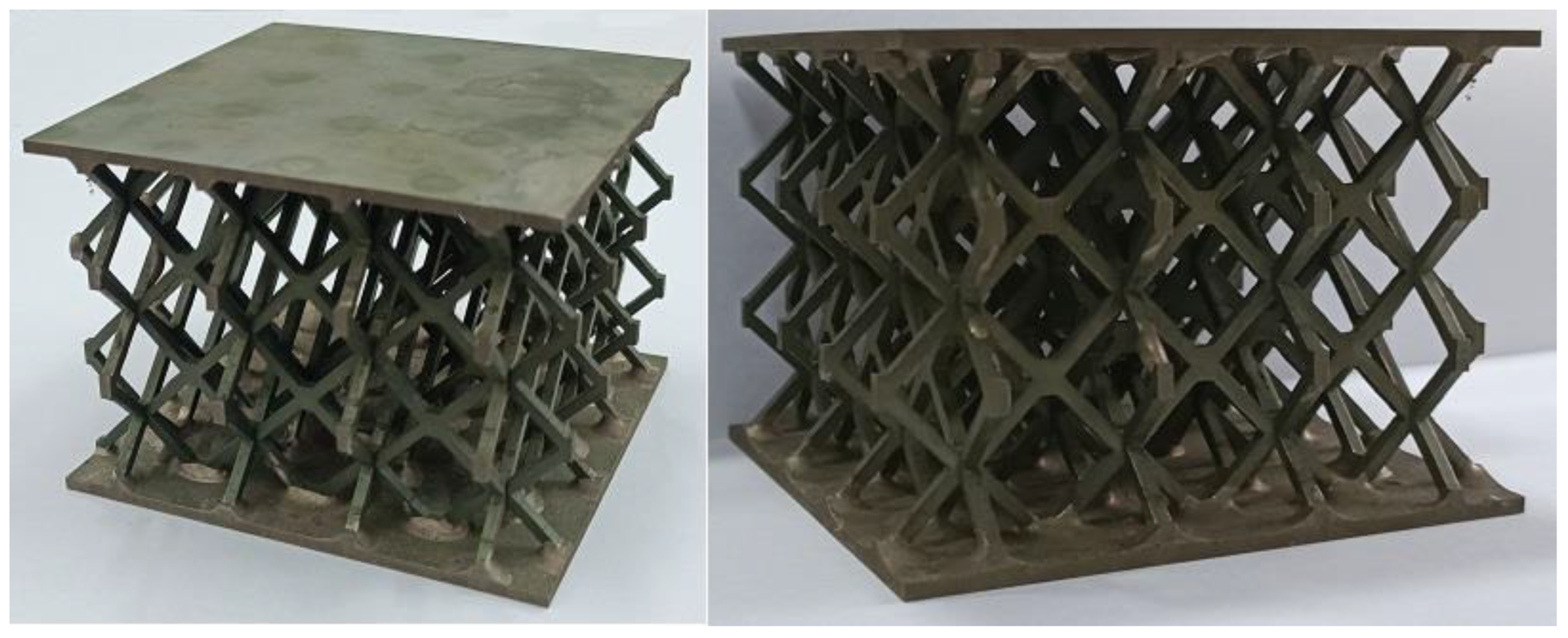

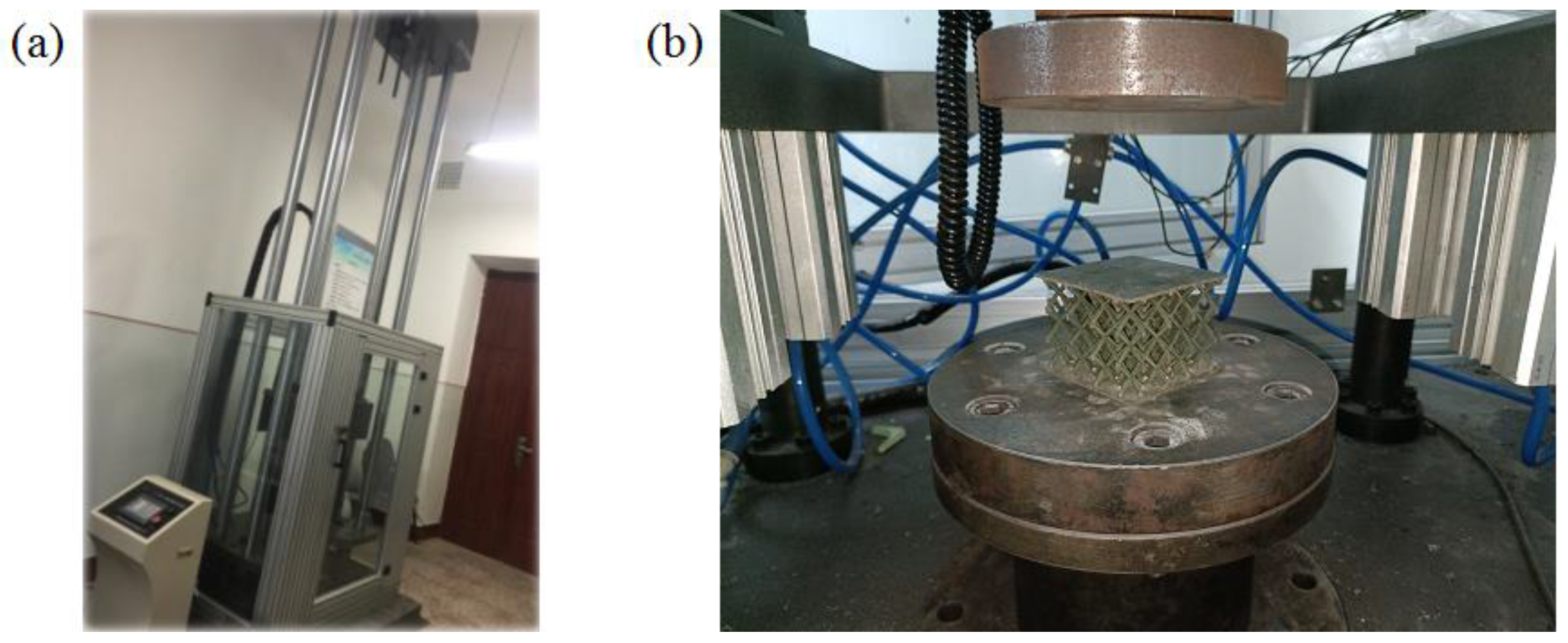

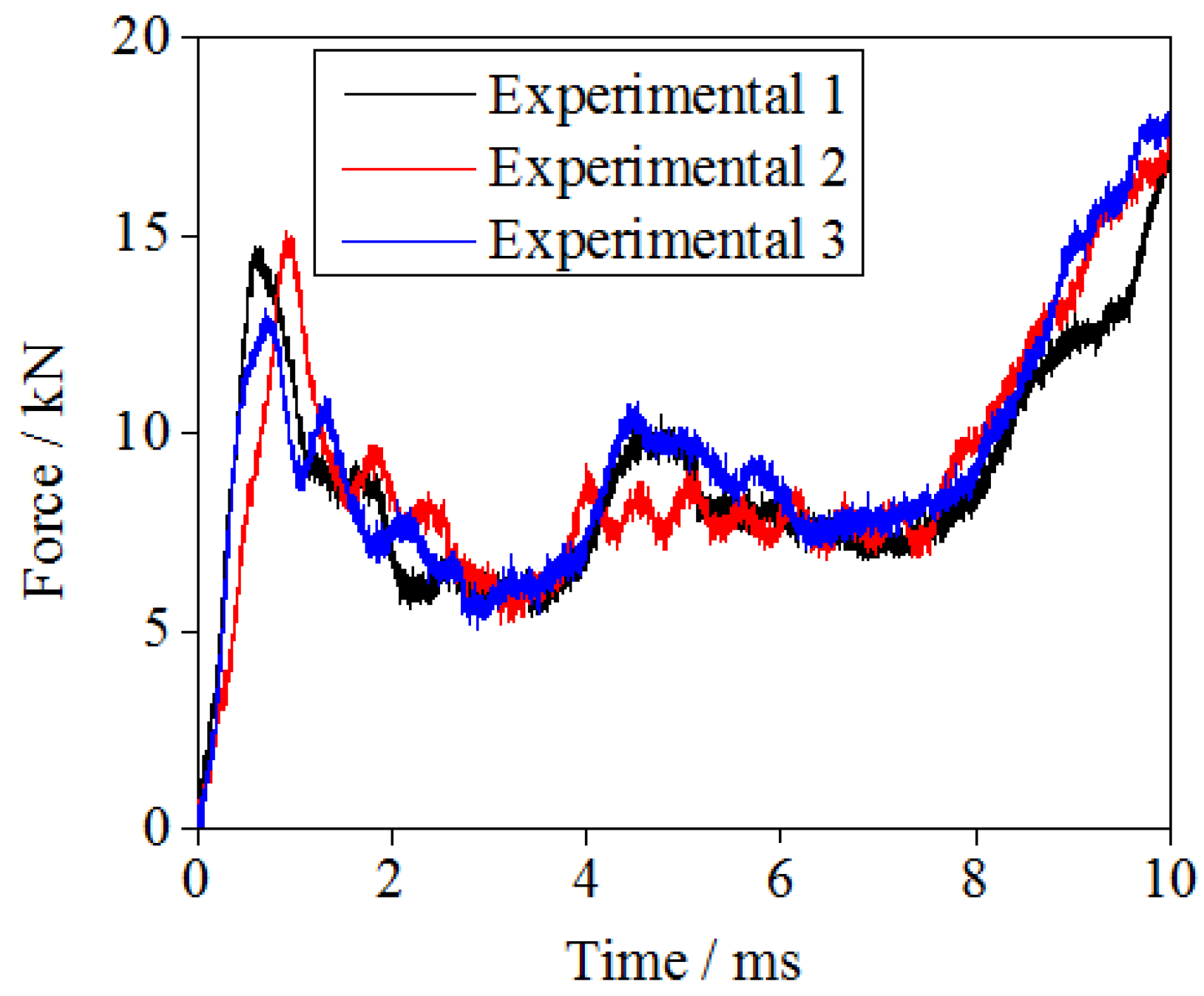
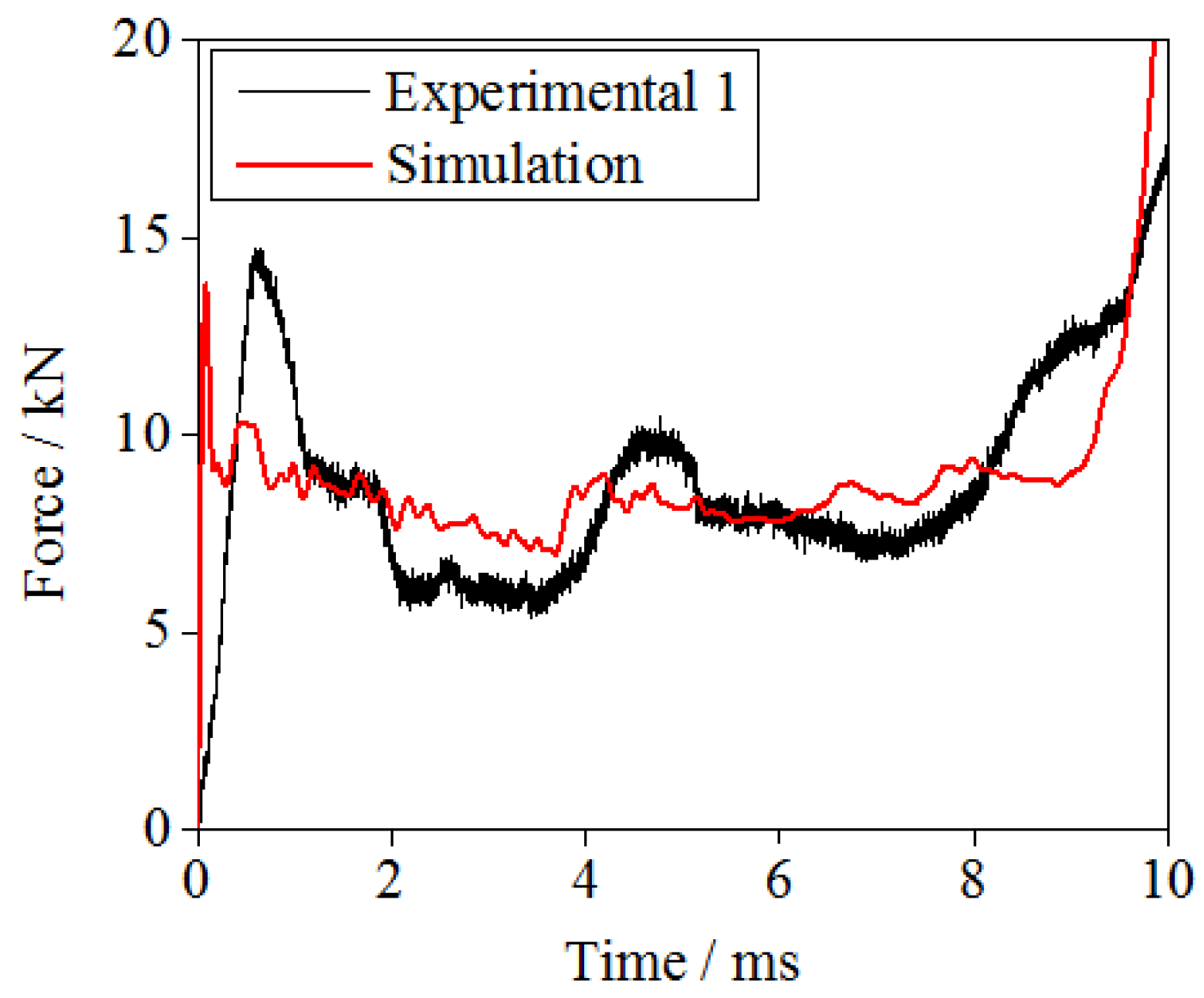
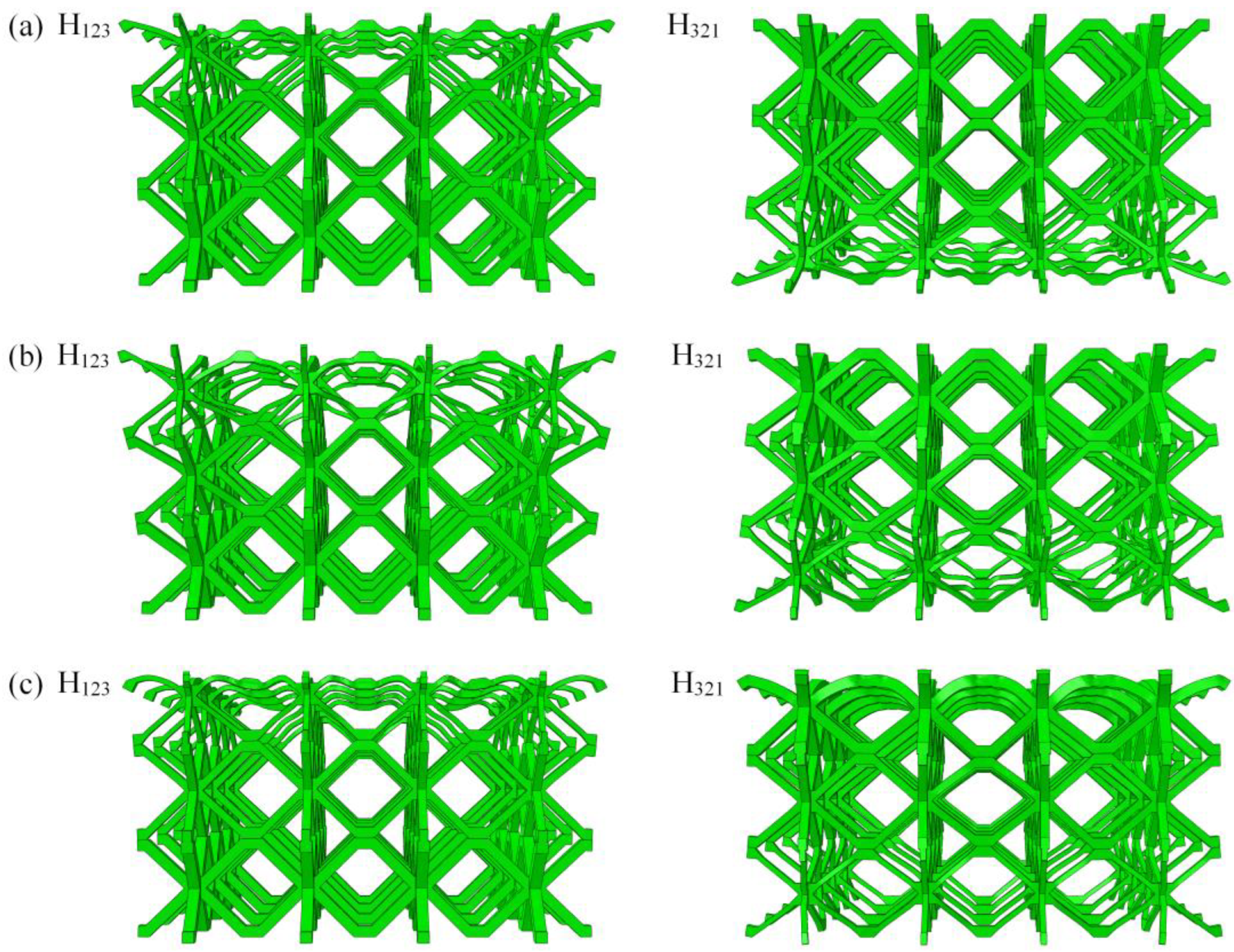
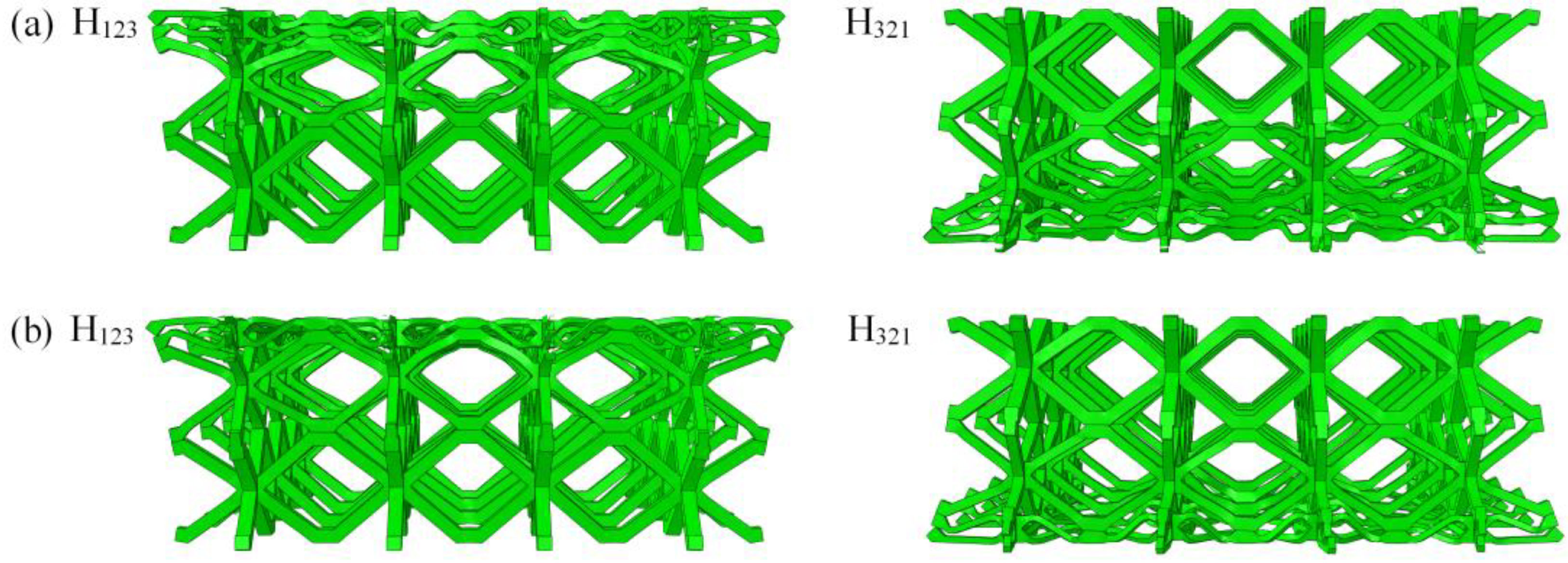

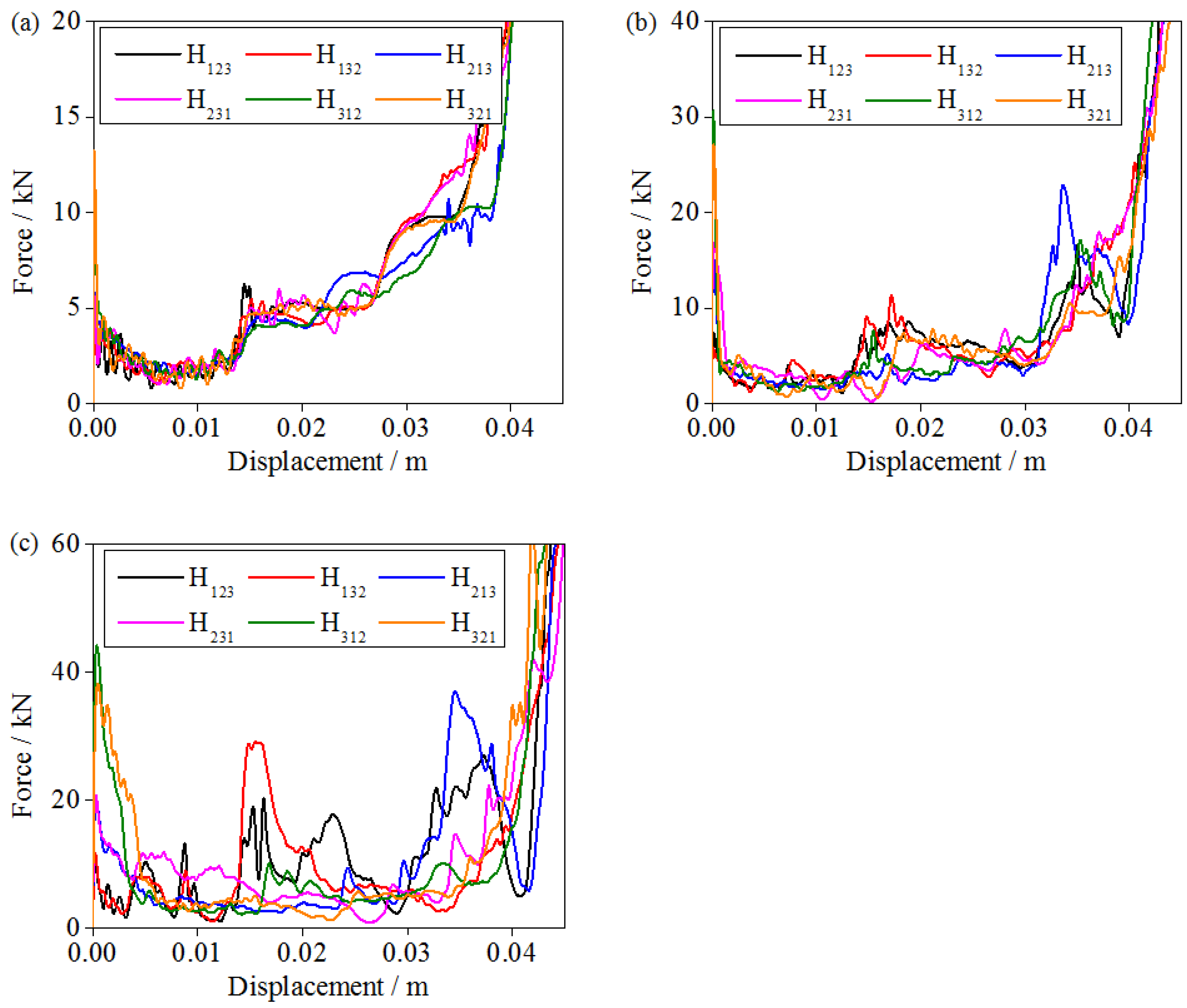
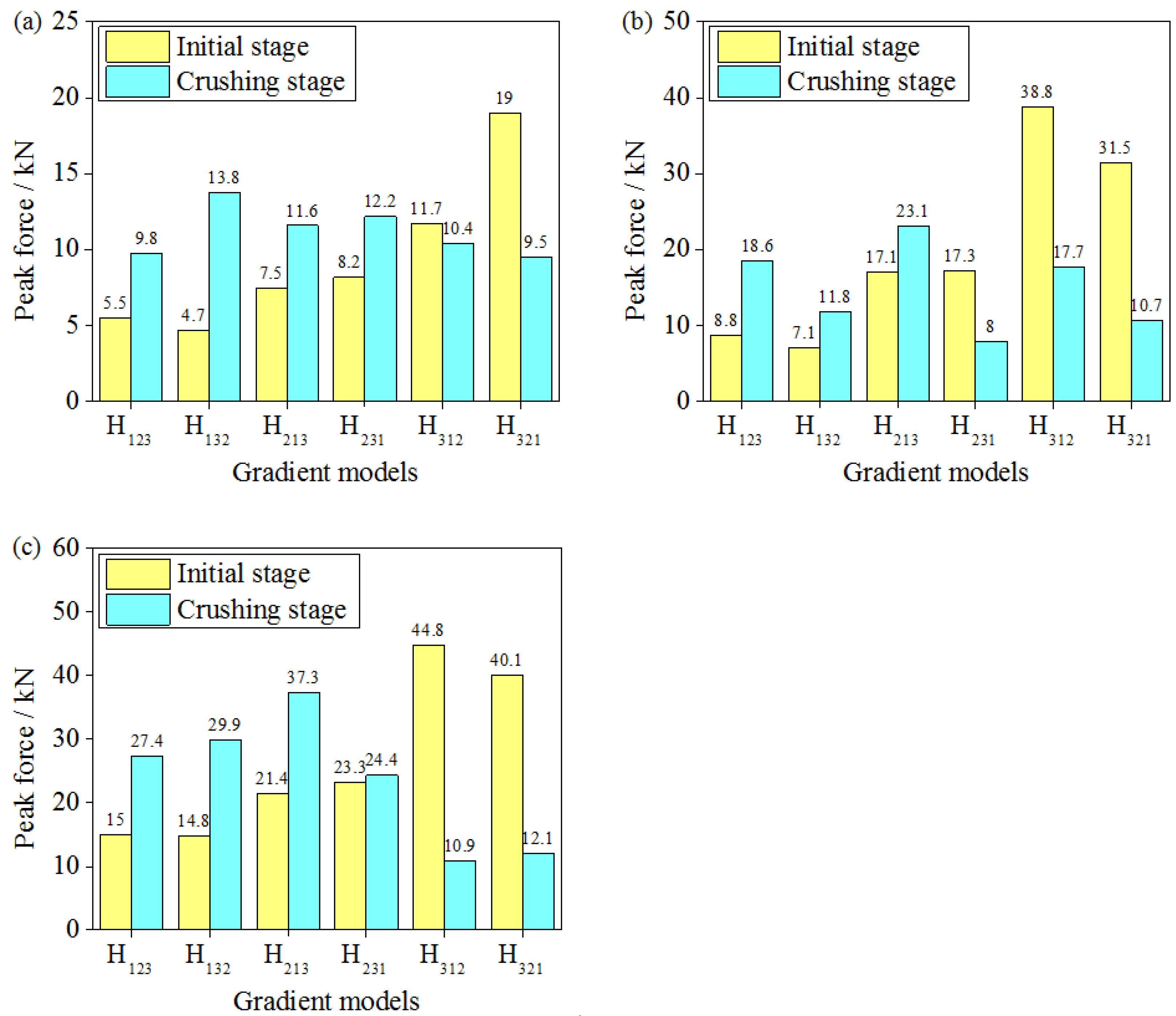

| Specimens | t1 (mm) | t2 (mm) | t3 (mm) | l (mm) | a + b (mm) | c (mm) | Δρ |
|---|---|---|---|---|---|---|---|
| H123 | 1 | 1.5 | 2 | 9.7 | 6.2 | 3.85 | 0.0358 |
| H132 | 1 | 2 | 1.5 | ||||
| H213 | 1.5 | 1 | 2 | ||||
| H231 | 1.5 | 2 | 1 | ||||
| H312 | 2 | 1 | 1.5 | ||||
| H321 | 2 | 1.5 | 1 |
Disclaimer/Publisher’s Note: The statements, opinions and data contained in all publications are solely those of the individual author(s) and contributor(s) and not of MDPI and/or the editor(s). MDPI and/or the editor(s) disclaim responsibility for any injury to people or property resulting from any ideas, methods, instructions or products referred to in the content. |
© 2023 by the authors. Licensee MDPI, Basel, Switzerland. This article is an open access article distributed under the terms and conditions of the Creative Commons Attribution (CC BY) license (https://creativecommons.org/licenses/by/4.0/).
Share and Cite
Wu, H.; Qu, J.; Wu, L. Experimental and Numerical Study on Impact Behavior of Hourglass Lattice Sandwich Structures with Gradients. Materials 2023, 16, 6275. https://doi.org/10.3390/ma16186275
Wu H, Qu J, Wu L. Experimental and Numerical Study on Impact Behavior of Hourglass Lattice Sandwich Structures with Gradients. Materials. 2023; 16(18):6275. https://doi.org/10.3390/ma16186275
Chicago/Turabian StyleWu, Hexiang, Jia Qu, and Linzhi Wu. 2023. "Experimental and Numerical Study on Impact Behavior of Hourglass Lattice Sandwich Structures with Gradients" Materials 16, no. 18: 6275. https://doi.org/10.3390/ma16186275





